To record some architectural thinking in the trip of Spain and Switzerland The site in Cadiz is a place 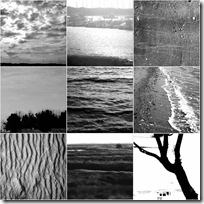 somewhere between nature and artificial environment. We see the profiles of parked cars layered on to the sea or skyscape, instead of in the customary urban background. The ocean, sand, wind, mountains, land, and trees are so close that the sudden awareness of these natural elements made me gaze at them again and again.
somewhere between nature and artificial environment. We see the profiles of parked cars layered on to the sea or skyscape, instead of in the customary urban background. The ocean, sand, wind, mountains, land, and trees are so close that the sudden awareness of these natural elements made me gaze at them again and again.
The Form of Nature These photos show their repeating zigzag curves that are created everywhere in nature. These patterns are so common but we stay isolated in our artificial society for so long that we can no longer recognize these patterns. In our built society the most nature we can see are the trees, clouds, and our own faces. Nature is able to make a palette of beautiful colors, a harmonious pattern, or a perfect shape so easily that for centuries all people believed that nature had its own cognition and intelligence. However modern science tells us that time, mutation, and evolution operating on a huge amount of matter are the main motivators of the various forms of nature. Humanity’s ability and intelligence are too weak to understand and control the whole treasure of nature’s forms, because the incredible immensity of the complexity of nature exceeds the capability of our memory and thinking. We just choose abstract forms that we can control, like the line, the circle, the curve, because people can remember, understand, and appreciate these simpler forms. Just these small straightforward parts of the treasure of nature are enough for human society.
People Hate the Randomness? The desire to control and discover nature is a basic emotion that has been within people for the all human history, which led the birth of science and the development of modern rational society. Plato led Western thinking towards the search for the ideal truth, which is part of the endeavor to find an understanding of nature which is comprehensible for human intelligence. People discovered the world like a child knocking on a table and finding joy from the sound their action makes. People were excited when they found the absolutely “perfection” within the early geometry. Even though many “perfect” rules were proved wrong shortly by new discoveries, people were still on the road of simplification and accustomed to disregarding the complexity of the nature world. Fortunately in the middle of the last century, people started to appreciate the importance of natural complexity and randomness. Society was built up on an abstracted rectangle, without any room for nature. If we can still see a glimmer of nature in the Art Nouveau, after the modernist movement’s functional and economic rules, the last flash of nature has been extinguished into a bunch of straight lines. We can say that the domestication of nature represents a huge accomplishment of human kind, but what I feel is the loss of the thrill when our boat bobbed in the middle of waves and the excitement when I walked into the clouds cloaking the Alps. What a pity for nature, what a pity for humans.
People Like Nature? One important aesthetic feeling of humans comes from nature. People always appreciate things more complex than themselves, which can be seen easily from the response of our body when meeting the wonders of the world - when we gaze at fire, sky, or mountain, our minds stop thinking and we simply marvel. Our reverence is part of our DNA and emerges in our society, in the form of religion, art, and eastern philosophies.
Nature Space
The spatial experience of nature became part of the human’s body when our ancestors ran in the forest, hid in the caves, and fished in Here, Herzog & de Meuron are using the whole gesture of the space to recall a nature space. In the Schaulager Museum of Basel, they tried to inject natural elements directly into the building. With simple solution to the urban problem, the building appears to make of raw earth, the curves inside caves, and waves of water. I can feel the odd switching between nature and human space, but as a whole, the building’s obvious attitude to the conventional urban surroundings emerges more than the natural visions. The situation is different in Peter Zumthor’s buildings. Nature is never an object or literal material used as a part of a building, but acts as a respected art piece valued by peaceful appreciation. The shutters of Shelters for the Roman Archaeological Site bring the outside wind and The apex of Zumthor’s attitude occurs at the Therme Bath in Vals. After enjoying the building’s exquisite materials, the various artistic representations of water, suddenly, I discovered the building acts a compass leading me from the deep inside of the earth to the peaks of Architectural space somehow is like the garment on the body. Herzog 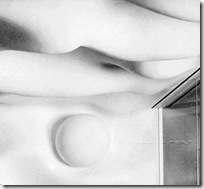 the sea. The primordial feeling is why I felt excited when we stood beneath Herzog & de Meuron’s Barcelona Forum. The experience of the space is not like a common building, but like the experience of being in the forest. A subtle slope connects with the outer space freely like grass with trunks under a canopy. The light shines though the holes, like sunlight permeates the leaves and projects beams of light onto the ground. The feeling of the space brings memories that belong to a world other than the urban world, but the space belongs to the modernity. It is enclosed with glass, steel sheets, and concrete; and used for contemporary affairs and surrounded by metropolitan Barcelona. Herzog & de Meuron use contemporary architectural elements to represent a memory of n
the sea. The primordial feeling is why I felt excited when we stood beneath Herzog & de Meuron’s Barcelona Forum. The experience of the space is not like a common building, but like the experience of being in the forest. A subtle slope connects with the outer space freely like grass with trunks under a canopy. The light shines though the holes, like sunlight permeates the leaves and projects beams of light onto the ground. The feeling of the space brings memories that belong to a world other than the urban world, but the space belongs to the modernity. It is enclosed with glass, steel sheets, and concrete; and used for contemporary affairs and surrounded by metropolitan Barcelona. Herzog & de Meuron use contemporary architectural elements to represent a memory of n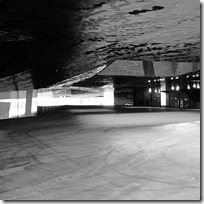 ature, but the experience is like talking to modern people with another creature’s language. My body felt a blurred but still familiar image of nature space. The enjoyment of the space doesn’t come from rational thinking.
ature, but the experience is like talking to modern people with another creature’s language. My body felt a blurred but still familiar image of nature space. The enjoyment of the space doesn’t come from rational thinking. 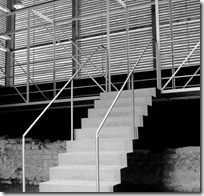 sound into the interior space. The building is built onto the site lightly – the floating entry, the wall blended with light, the thinness of the staircase, corridor, and the louver, all of which show Zumthor’s attitude to keep the untouched site as untouched as possible.
sound into the interior space. The building is built onto the site lightly – the floating entry, the wall blended with light, the thinness of the staircase, corridor, and the louver, all of which show Zumthor’s attitude to keep the untouched site as untouched as possible. 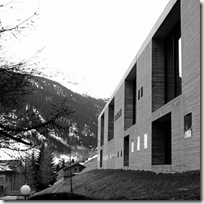 the Alps. The images of mountain are shown in different windows or frames, combined with steam, water, rain, snow, or wind. Even the gaps on the roofs/ceilings seem to hint that the building is an aggregation of stones in water. People can see through the gaps between the stones to the surroundings.
the Alps. The images of mountain are shown in different windows or frames, combined with steam, water, rain, snow, or wind. Even the gaps on the roofs/ceilings seem to hint that the building is an aggregation of stones in water. People can see through the gaps between the stones to the surroundings.  & de Meuron’s Barcelona Forum and Schaulager Museum are like using a beautiful fabric to make chic garment, or reproducing a curve of the body with cloth without the existence of the body. Sometime we almost forget the original beauty of the body when looking at these projects. Zumthor’s designs are more like Issey Miyake’s designs – using the material of cloth to wrap the body thus show its beautiful curve. In the work of other architects, we can hardly see the body, but only the cloth.
& de Meuron’s Barcelona Forum and Schaulager Museum are like using a beautiful fabric to make chic garment, or reproducing a curve of the body with cloth without the existence of the body. Sometime we almost forget the original beauty of the body when looking at these projects. Zumthor’s designs are more like Issey Miyake’s designs – using the material of cloth to wrap the body thus show its beautiful curve. In the work of other architects, we can hardly see the body, but only the cloth.



No comments:
Post a Comment